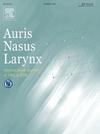Endoscopic surgical strategy for highly vascular pediatric sinonasal and pterygopalatine fossa tumors
IF 1.5
4区 医学
Q2 OTORHINOLARYNGOLOGY
引用次数: 0
Abstract
Pediatric sinonasal tumors are rare, and minimally invasive approaches are preferred because of unknown long-term effects on development. We report three cases of highly vascular pediatric sinonasal and pterygopalatine fossa tumors that were successfully removed using an endonasal endoscopic approach with transcatheter arterial embolization (TAE). The patients (9–11 years old) had contrast-enhanced tumors in the left ethmoid sinus near the sphenopalatine foramen in case 1, in the right nasal cavity near the sphenopalatine foramen in case 2, and in the right pterygopalatine fossa in case 3, with diameters of 32, 50, and 61 mm, respectively. Computed tomography and magnetic resonance imaging demonstrated tumors with strong contrast enhancement and flow voids in all cases. TAE was performed in all cases on the day of surgery, followed by endoscopic sinus surgery with nasal septal modification. Pathology revealed pyogenic granuloma, nasal polyps, and juvenile angiofibroma. After TAE, tumor reduction improved visualization in case 1. Nasal septum manipulation enabled medial traction and tumor base identification in cases 2 and 3. The combination of preoperative TAE and septal modification proved effective for achieving complete endoscopic tumor removal. No complications occurred, and follow-up at 1–1.5 years showed no tumor recurrence or developmental abnormalities.
高血管性儿童鼻窦和翼腭窝肿瘤的内镜手术策略
小儿鼻窦肿瘤非常罕见,由于对发育的长期影响未知,因此首选微创方法。我们报告了三例高血管性小儿鼻窦和翼腭窝肿瘤病例,采用鼻内窥镜方法和经导管动脉栓塞(TAE)成功切除了肿瘤。患者(9-11 岁)的对比增强肿瘤直径分别为 32 毫米、50 毫米和 61 毫米,病例 1 位于左侧乙状窦,靠近蝶骨孔;病例 2 位于右侧鼻腔,靠近蝶骨孔;病例 3 位于右侧翼腭窝。计算机断层扫描和磁共振成像显示,所有病例的肿瘤均有强对比度增强和血流空洞。所有病例都在手术当天进行了TAE,随后进行了鼻腔内窥镜鼻窦手术,并对鼻中隔进行了修整。病理结果显示为化脓性肉芽肿、鼻息肉和幼年血管纤维瘤。TAE 术后,肿瘤缩小改善了病例 1 的视野。在病例 2 和 3 中,鼻中隔操作实现了内侧牵引和肿瘤基底识别。事实证明,术前TAE和鼻中隔矫正术的组合能有效实现内窥镜下肿瘤的完全切除。手术未出现并发症,1-1.5 年的随访显示肿瘤未复发或发育异常。
本文章由计算机程序翻译,如有差异,请以英文原文为准。
求助全文
约1分钟内获得全文
求助全文
来源期刊

Auris Nasus Larynx
医学-耳鼻喉科学
CiteScore
3.40
自引率
5.90%
发文量
169
审稿时长
30 days
期刊介绍:
The international journal Auris Nasus Larynx provides the opportunity for rapid, carefully reviewed publications concerning the fundamental and clinical aspects of otorhinolaryngology and related fields. This includes otology, neurotology, bronchoesophagology, laryngology, rhinology, allergology, head and neck medicine and oncologic surgery, maxillofacial and plastic surgery, audiology, speech science.
Original papers, short communications and original case reports can be submitted. Reviews on recent developments are invited regularly and Letters to the Editor commenting on papers or any aspect of Auris Nasus Larynx are welcomed.
Founded in 1973 and previously published by the Society for Promotion of International Otorhinolaryngology, the journal is now the official English-language journal of the Oto-Rhino-Laryngological Society of Japan, Inc. The aim of its new international Editorial Board is to make Auris Nasus Larynx an international forum for high quality research and clinical sciences.
 求助内容:
求助内容: 应助结果提醒方式:
应助结果提醒方式:


